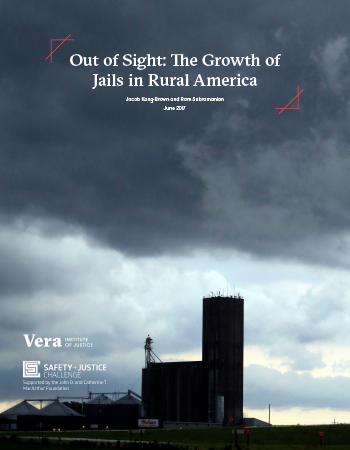Interagency Collaboration Jail Populations Rural Jails September 6, 2017
On any given day, there are more than 730,000 people incarcerated in more than 3,000 local jails across the United States. While many people assume that high incarceration rates are only concentrated in major cities, a recent report by the Vera Institute of Justice reveals that, in fact, small and rural counties are the main drivers of jail growth across the country. One of the factors cited in Vera’s report is a lack of resources—meaning that small and rural counties often lack infrastructure for social services, such as readily available community treatment facilities, and face a unique set of challenges within their criminal justice systems.
“Small and rural counties” references a subset of “rural to small and medium metros” as defined in Vera’s report and excludes Safety and Justice Challenge sites that are the first or second most populous counties in their state.
Despite challenges, these counties remain dynamic incubators for change, poised to quickly bring multiple stakeholders together and foster collaboration. A recent addition of Innovation Fund sites to the Safety and Justice Challenge (the Challenge) has created an opportunity to test out bold ideas in 20 new places. Through our work at the Urban Institute to support project implementation, we can witness how smaller jurisdictions seek to overcome these challenges and implement reforms that are responsive to the needs of their communities.
Innovation Sites offer a unique look into how jail growth manifests in smaller areas
The addition of six Innovation sites—Buncombe County, North Carolina; Campbell County, Tennessee; Deschutes County, Oregon; Durham County, North Carolina; Summit County, Ohio and Yakima County, Washington—greatly expanded the Challenge network in small and rural communities.
Challenges that small and rural counties face are not unique in their existence, but are unique in the way they manifest. As a result, localities must tailor solutions to best meet their needs.
Scarce resources leave little room for innovation and risk
Smaller sites have limited ability to start new programs and ensure their fidelity. The issues of staffing, finding a location to host new programs, and securing funding beyond seed investments are all major hurdles. Campbell County, a rural jurisdiction in Tennessee, planned to incorporate a gender-responsive assessment and case planning tool. However, their choices were limited to tools that are offered at a reasonable price and at an accessible location without compromising the quality of training. Campbell County successfully overcame this barrier by exploring alternative assessments that were of high quality and could provide immediate online training, which would better fit the county’s timeline and budget restraints.
Another example is Deschutes County, Oregon, which is piloting a diversionary pre-charge program for people suspected of possession of a controlled substance. Deschutes faced various implementation challenges such as staffing, finding a location to host meetings, and developing a triage center. In collaboration with multiple stakeholders, they were able to strategize other options, such as using a temporary space until they could find something more long-term. As a result, Deschutes County developed an innovative program to divert people with substance abuse needs to more appropriate community treatment options and has built a community that seeks to continue to build on their current work moving forward.
Fewer community options for behavioral health treatment bring too many people to jail
Both large and small communities are struggling to find effective solutions and stop the unnecessary incarceration of people with behavioral health needs. Because small and rural counties rarely have adequate community alternatives, an overreliance on jail persists. Yakima County, Washington is addressing this issue comprehensively by using the Sequential Intercept Model, a conceptual framework to address the community-wide interface between criminal justice and behavioral health systems. Through this model, Yakima seeks to enhance its continuum of care for people with serious mental illness and to expand its options to divert people at any point within the criminal justice system. This continuum will integrate current intervention options such as the county’s dual diagnosis court, behavioral health diversion, and pretrial services.
Buncombe County, North Carolina has been successful with timely screening and assessment. They rely on pretrial services as well as mental health and substance abuse counselors at the detention center to appropriately assess and diagnose people and divert them to community treatment. Such solutions are not yet scaled, but they are a step in the right direction and a signal to other similar-sized communities that something can and should be done about this pervasive issue.
Despite challenges, small and rural counties have a unique opportunity to affect positive criminal justice reform.
Small and rural counties have a collaborative advantage to resolving issues in their criminal justice systems: because of their size, they can often quickly bring multiple stakeholders to the table to make decisions and come to consensus. This also allows for better coordination, which can improve the way the system works for the people passing through it. For instance, Campbell County set up bi-weekly meetings with key stakeholders, including corrections staff, the judiciary, and key staff involved in the county’s drug courts to discuss and build out their Women in Need Diversion program as well as promptly review cases at the point of referral. Yakima did the same, pulling together key stakeholders from multiple departments and agencies to strategize the best way to link their systems.
Perhaps the most important opportunity that rural and smaller jurisdictions have is that their change makers are members of these close-knit communities. They are engaging in true ground-up community work creating change in a manner that is responsive to the needs of their people. When someone has a real stake in making their own community better, reforms acquire a different and more positive sense of ownership and meaning.











